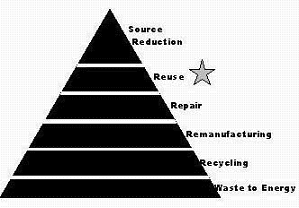|
It is important to recognize that the sustained
growth in reuse efforts, as well as the sustained interest of the reuse
industry, derives in large measure from the solid waste reduction
hierarchy: Reduce, Reuse, then Recycle. It is best to reduce first, reuse
as a second option, then to resort to recycling. Reuse is recognized as
being distinct from recycling, both in doctrine, and in the handling of
the materials this unique industry diverts from the waste stream.
Recyclers have successfully kept materials out of the landfill by
collecting, segregating, processing and manufacturing their collected
goods into new products. Reusers, on the other hand, with little or no
processing, keep materials out the waste stream by passing the goods they
collect on to others.
There are also forms of managing materials that are
not quite reuse and not quite recycling.
§
Repair is a method of taking an item, which may
appear to have lived its useful life, and fixing it so that it can still
be productive.
§
Remanufacturing and refurbishing are ways of
taking some used components and some new components to "rebuild" an item.
For instance, toner cartridges are often used, then sent to a manufacturer
to be broken down and rebuilt using some of the original parts that are
reusable, and some new parts. Other items commonly repaired or rebuilt
include engines, "single-use" cameras, appliances and electronic
equipment.
Reuse is a means to prevent solid waste from entering
the landfill, improve our communities, and increase the material,
educational and occupational wellbeing of our citizens by taking useful
products discarded by those who no longer want them and providing them to
those who do. In many cases, reuse supports local community and social
programs while providing donating businesses with tax benefits and reduced
disposal fees.

Environmental Benefits
Many reuse programs have evolved from local solid
waste reduction goals because reuse requires fewer resources, less energy,
and less labor, compared to recycling, disposal, or the manufacture of new
products from virgin materials. Reuse provides an excellent,
environmentally-preferred alternative to other waste management methods,
because it reduces air, water and land pollution, limits the need for new
natural resources, such as timber, petroleum, fibers and other materials.
The US Environmental Protection Agency has recently identified waste
reduction as an important method of reducing greenhouse gas emissions, a
contributing factor to global warming.
Community Benefits
For many years, reuse has been used as a critical way
of getting needed materials to the many disadvantaged populations that
exist. Reuse continues to provide an excellent way in which to get people
the food, clothing, building materials, business equipment, medical
supplies and other items that they desperately need. There are other
ways, however, that reuse benefits the community. Many reuse centers are
engaged in job-training programs, programs for the handicapped or at-risk
youth programs. Such as:
§
The Resource Center of Our United Villages in Portland,
Oregon has a mission to provide building materials for affordable housing
and reused building materials is their means for accomplishing that
mission;
§
St. Vincent dePaul in Portland refurbished mattresses as
a means of employing and training their clients, and a way to provide
mattresses to people and organizations in need;
§
Goodwill Industries retail outlets raise needed funds to
support job-training programs in the community.
Economic Benefits
When reusing materials, instead of creating new
products from virgin materials, there is less burden on the economy.
Reuse is an economical way for people of all socio-economic circles to
acquire the items they need. From business furniture to household items,
from cars to appliances, and just about anything else you could think of
-- it is less expensive to buy used than new.
What Is Reuse?
Reuse is the
Solution
While manufacturing new
products drains our limited natural resources, and disposing of unwanted
materials pollutes our environment, our communities face difficulties
getting the affordable goods they need.
One way to prevent waste, improve our communities, and increase the
material well-being of our citizens is to take useful products discarded
by those who no longer want or need them and provide them to those who do.
Every community has some
existing form of reuse – and, every community needs more reuse now!
Volunteer efforts, for-profit businesses and charities are all making
reuse happen, including:
·
thrift stores and charitable
drop-off centers;
·
reuse centers, equipment and
materials;
·
"drop & swap" stations at
landfills;
·
used equipment stores and salvage
yards;
·
local and regional material
exchanges.
Reuse Supports Solid
Waste Management Goals
Buying and using items
that are reusable supports a method of waste management that has been
identified by the U.S. Environmental Protection Agency and others, as a
priority method of handling materials. In many cases an item can be reused
several times, then sent to the recycling center for processing. The list
of reused items is virtually unlimited, and reuse centers can be found in
nearly every community.
Building Materials –
Lumber, tools, windows, doors, light fixtures,
paint, plumbing supplies and fixtures, architectural pieces, fencing,
hardware, and many other items needed for constructing or refurbishing a
building can be found used.
Office Furniture and Supplies –
Desks, tables, chairs, filing cabinets,
credenzas, shelving units, stacking trays, tape dispensers, notebook
binders and other equipment and supplies can be reused in offices,
schools, hospitals, non-profit organizations and others.
Computers and Electronics –
Personal computers, printers, fax machines,
televisions, video cassette recorders can be reused in business, personal,
and non-profit environments.
Art Materials –
Fabric, paint, lumber, stage props, and a wide
variety of other items can be used for school or cultural organization
creative projects.
Medical Equipment and Supplies –
Equipment and supplies that are obsolete to one
hospital, clinic or organization may find a home in another facility,
especially those in less-industrialized nations.
Surplus Food Items and Equipment –
Boxed, bagged, canned and even prepared food
from grocery stores, warehouses, manufacturers' over-runs and discontinued
items, catered events, restaurants can be reuse by homeless shelters, soup
kitchens, and other organizations serving disadvantaged people. Stoves,
refrigerators, freezers, and other items can also be found used.
Household Items –
Appliances, clothing, furniture, dishes,
vehicles, paint, and virtually anything else for the home can be found by
shopping reused instead of brand new. And in most cases, at a
significantly lower price. Another form of reuse is shopping specialty
stores that sell antiques or vintage items. Shopping and holding garage
and yard sales are other popular forms of reuse.
Reuse Means
Value-Added!
Reusing an item means that
it continues to be a valuable, useful, productive item, and replaces new
items that would utilize more water, energy, timber, petroleum, and other
limited natural resources in their manufacture. Businesses can save
significant dollars in disposal by reselling or donating items that are no
longer needed. Many chemicals and solvents that are no longer useful to
one organization, can be used in other applications by other
organizations. This method of "materials exchange" results in disposal
savings by the generating company, and saving in the purchase of the
material by the recipient organization. Reuse adds value!
Reuse Supports Community Development Goals
In addition to making a
positive contribution to the reduction of solid waste, many reuse programs
in a community are operated by charitable organizations as a means of
providing items to low-income or disadvantage people. Donating your
surplus items can also help furnish a non-profit's office and provide a
school with needed supplies, further supporting the community in which you
live.
ReDO Information
ReDO's information and
services are available to everyone interested in furthering reuse efforts.
For more information on Reuse
Development Organization, Inc. or reuse,
info@redo.org.
|
